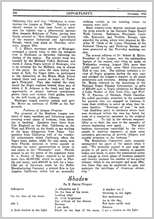
"Shadow" as it first appeared in Opportunity magazine, 1925.
- Printable version (PDF, 376 KB)
- Text transcription (PDF, 45 KB)
- Learn more about this period
A great explosion of artistic creativity rocked the United States in the 1920s, and its center was in Harlem. Innovative young African American writers, painters, and musicians had been gathering in that upper Manhattan neighborhood since the beginning of the century, working together and developing new ideas, and in the years after World War I they gained national attention. Although they were all fiercely individualistic talents, these artists were soon identified as being part of a movement. The writers Langston Hughes, Jessie Fauset, Countee Cullen, and Zora Neale Hurston; the composers Duke Ellington and Eubie Blake; and the painters Romare Bearden and Jacob Lawrence all became known as members of the Harlem Renaissance.
The writer and artist Richard Bruce Nugent played a key role in the Harlem Renaissance, even though his output was small. He helped found two new literary journals, Fire!! and Harlem, but lacked confidence in his own work. His first poem to be published, “Shadow,” had to be rescued from his own wastebasket by Langston Hughes, who eventually convinced him to send it to Opportunity magazine. The poem was included in most of the African American anthologies of the time, but Nugent himself never saw it as a poem about race, but about loneliness and being treated as someone different. As you read the poem, notice the ways the poet describes loneliness, and think about all the different things that could make a person feel like he or she stands out.
Learn more
For more background information on this period, visit these presentations.

